Malda – the first thing that comes to our mind about Malda is mangoes. But Malda is much more than that. Malda has a very rich history and was the seat of power for many empires. Malda thus has a few historical relics scattered throughout with Gour and Panduah being the most famous. We had lived in Malda for more than 4 years for work. During that period, we explored the town and visited the historical sites of Gour, Pandua and Old Malda.
To be honest, the historical sites of Gour in Malda are a treasure trove for historians. Located very near to the India-Bangladesh border at Mahadipur, Gour is visited by a number of tourists all through the year. Here, we have written about the must-visit and main historical sites of Gour, Malda. After all, it is a part of our past that needs to be known.

History of Gour Malda
The history of Malda can be traced back to the medieval periods and centres around the cities of Gour and Pandua. Gour or Gaur being an ancient city, its mention can be found even in the Hindu Puranic texts. The historical records of the city, however, can be traced from 500 BC from the time of the Mauryan Dynasty. From the period of Mauryas, Gour and the region of Pandua, then known as Pundrabardhana came under the reign of the Guptas. They were succeeded by Sasanka. He was the king of Karnasubarna as well as the king of Gour in the beginning of 7th Century AD and ruled for almost 3 decades. From the middle of the 8th century to 11th century the Pala dynasty ruled Bengal. They were great followers and propagators of Buddhism and the religion flourished under their reign. The Pal dynasty yielded to the Sen Dynasty who was ardent followers of Hinduism. Unlike the Pals, the Sens did not encourage the propagation of the other religions. During the reign of Lakshman Sen, Gour was known as Lakshmanbati. The Sen Kings ruled Bengal till Bakhtiyar Khilji conquered Bengal in 1204 AD.
The Muslim rule lasted for about 500 years before Nawab Siraj-ud-Daula was defeated by Lord Clive in the battle of Plassey in 1757 thus changing the course of Indian history.
From the ancient period different rulers with different beliefs, religion and dynasty had left the mark of their dynasty, but most have failed the test of time. New rulers had obliterated the previous marks left by their predecessors. But whatever remains are now in ruins and relics, nevertheless reminds the resplendence and grandeur of the time.

Gour, Malda – the ancient city of Bengal
Gour has many architectural structures of historical importance and is sure to attract history and archaeology buffs. Many historical relics are located along the road till you reach Mahadipur, the Indo-Bangladesh border. Most of these ancient monuments are surrounded by beautiful and well-maintained gardens.
-
Kotwali Darwaza

We started from the Indo – Bangladesh border at Mahadipur, A giant red stone structure stands here, known as the “Kotwali Darwaza”. Probably named after the chief of police (Kotwal in Persian), the gate was stationed to guard the southern wall of Gour. It was built during the fifteenth century following the move of the capital from nearby Pandua to Gaur in 1446.

The gate is now in ruins and only the external towers with a huge convex outline with rows of arrow-slits can be partially seen. The rampart walls on the sides of the towers are still in existence. Presently, the Kotwali Darwaza serves as the border between India and Bangladesh.
BSF Jawans are stationed at the place and you have to obtain permission from them to visit the ruins and even take photographs of the place.
-
Lottan Masjid

Further down the road, stands the Lottan mosque. It is one of the finest architecture of the period having a single domed structure. The mosque was probably built between 15th to 16th century by Sultan Yusuf Shah. The entire building is built of bricks consisting of a square prayer chamber. The mosque was earlier covered beautifully with coloured bricks remains of which can be seen till today. The surrounding luscious green garden provides a perfect backdrop to this mosque.
It is believed that the mosque was built in memory of a royal courtesan named Lottan.
-
Tanti Para Mosque

A few metres down the road, your eyes will automatically be riveted by the sight of a green lawn and a ruined structure. It is the Tanti Para mosque. This gigantic Mosque built and completed by Sikandar Shah in 1369 AD is the most remarkable existing example of Muslim architecture of that period.
It is a Quadrangular building originally covered with 10 domes which have now fallen. To the northern half of the back wall of the mosque lies a roofless room and is known as Sikandar Shah’s tomb.
The mosque was so-called because it was situated in the weaver’ colony of Gour kingdom. The building has intricate works which show the beauty of the architecture of the period. The garden is also well maintained by the Archaeological Survey of India.
-
Lukachuri Gate
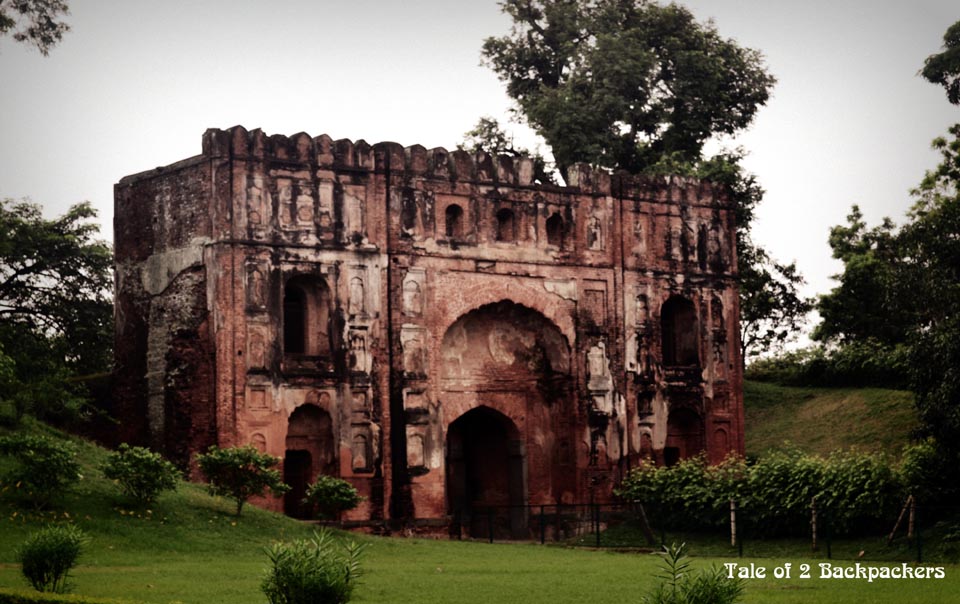
Next, we passed through the “Lukachuri Gate”. It appears to have been built by Shah Suja, brother of the Mughal emperor Aurangzeb in 1655 AD. This has a large double-storeyed gate, with guard’s room on sides and a Naqqar Khana (drummers chamber) on top is built of brick and stone and is the eastern entrance into the citadel of Gaur.
The high arch is cusped, while the sides are panelled showing multi-cusped arches. The gate was originally named “Shahi Darwaza” and was used by Shah Suja for entering his palace. Legend has it that the gate was so named as the Sultan and his Begums played hide and seek (Bengali- Lukachuri) here during their leisure.
-
Qadam Rasul Mosque

As you enter the Lukachuri gate, to the right side stands the Qadam Rasul mosque. The mosque was made with ornamented bricks. It has a single domed structure with a square interior and verandah on the three sides. It was built by Sultan Nusrat Shah in 1530. It is said that the footprints of Prophet Hazrat Mohammad were enshrined here.
-
Fath Khan’s Tomb

Beside the Qadam Rasul mosque, stands Fath Khan’s tomb. The tomb is dedicated to Fath Khan, son of Dilawar Khan, Aurangzeb’s general who was sent by the emperor to kill Saint Niamatullah. It is said that Aurangzeb’s son, Sultan Shuja had rebelled against his father on the advice of Saint Niamatullah. Fath Khan was believed to have vomited blood and died at this spot.
The beautifully ornate carvings on the walls of the ruins and the images of Hindu idols on the stonework of doors and lintels are still partly visible.
Scholars and historians believe that there was considerable Hindu influence in this area. Later with the rise of Jalaluddin Mohammad Shah, the son of Raja Ganesh, who had converted himself to Islam, had destroyed the majority of the temples of Gour and Pandua. He had destructed the architecture, dismantled the idols and plunged them into nearby pools and lakes. A few years back, a local of Gour had found historical relics, coins from the nearby ponds of Gour.
-
Chika Masjid or Chamkan Mosque
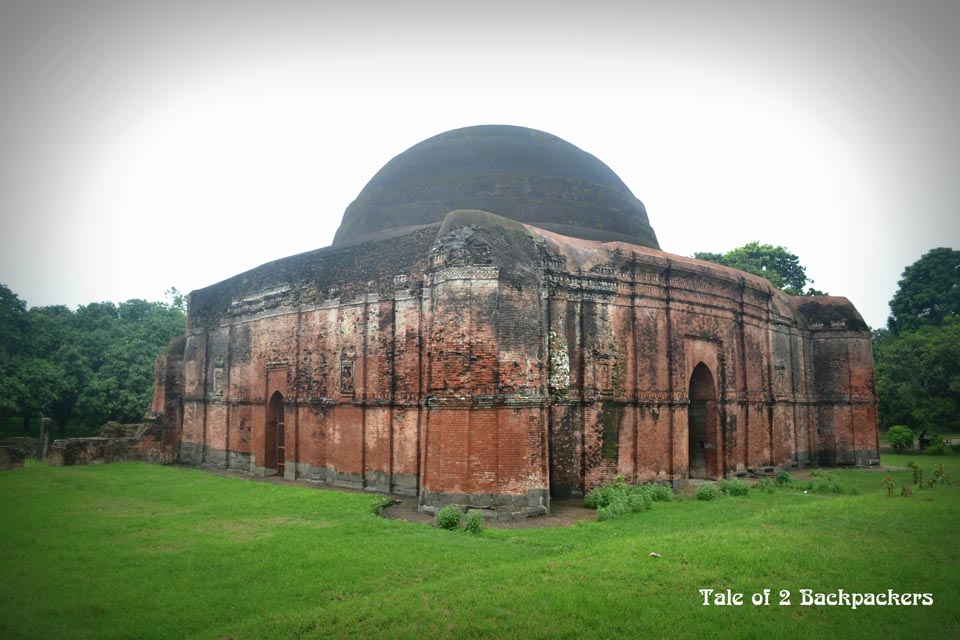
To the left of the Lukachuri gate lies the Chika Masjid or Chamkan mosque. This single domed structure was built around 1450 AD by Sultan Hussain Shah. The mosque is actually a mausoleum and was used by the Sultan as a prison. It is said that Sultan Hussain Shah had imprisoned his Hindu Ministers Roop and Sanatan Goswami here. The two later became disciples of Sri Chitanyadeva and quit their Royal service.
The name “Chika” probably came from bats (chika means bats). After it was deserted, the building had become an abode of bats.
Just opposite the Chika Masjid is the Gumti Gate built by Sultan Hussain Shah in 1512 AD. This single-domed structure embellished with enamelled bricks was used as an eastern gateway into the Citadel of Gour. This was a private entrance to Gour hidden under time. It is being excavated now.
-
Firoz Minar

Our next stop was the Firoz Minar. Alternately known as Firoza Minar or ‘Blue Tower’ this tower 25.60 m high with spiral staircase having 73 steps was probably constructed by Saifuddin Firoz an Abyssinian commander of the royal forces who became the Sultan by avenging the killing of Sultan Jalaluddin Fath Shah, the last ruler of the Iliyas Shahi dynasty. This is considered as a victory tower as its builder is credited with many victories in battles. Scholars attribute it as a Bengali version of the Qutub Minar.
There is a pleasant charm to the Firoz Minar with a large Banyan Tree and an oak tree standing side by side.
The Excavation Sites of Gour Malda
The excavation sites at Gour, Malda tells the tale of the erstwhile kingdom of the Bengal rulers. A bye lane from the road towards Firoz Minar from Qadam Rasool mosque will take you to the excavation sites. There is very little of the road, it is just a muddy and dusty path. A few minutes’ walk or you can take your vehicle too and you will be standing in front of a mammoth wall – the Baisgazi wall.
-
Baisgazi Wall

There is a huge wall called the “Baisgazi Wall”. As the wall is measured 22 Bengali yards i.e. 42 feet in its height it is called Baisgazi wall.
This massive brick-built wall with ornamental cornices and niches was probably built during the reign of Sultan Nasiruddin Mahmud Shah as a protective wall for the palace area of the Kingdom of Gaur. It has a tapering shape and 15 feet wide at the base and near 9 feet at the top. The walls are now in ruins and give the place a haunted feel.
The construction of the wall shows how the kingdom of Gour was protected on the three sides by this huge wall.
-
Ballal Bati

A walk of about 5 minutes through the mango orchards will take you to Ballal Bati, the excavation site. The site revealed dome-like structures which look like Buddhist Stupas.
A further walk will take to an ancient falling wall which gives the impression that this might have been the Durbar of the King. Excavations to this site are still being carried on.
-
Jahajghata

A nearby excavation site reveals an ancient Jetty sort of construction. This site is known as “Jahajghata” it was probably an ancient port used by the kingdom when the river flowed by the palace before changing its course.
Gour has a lot of historical relics which has the mark of both Hindu and Islamic architecture. These sites, if maintained properly can be of great value historically as well as can attract tourists.
Some Useful Facts about Gour Malda
How to reach Malda?
Malda is about 330 km from Kolkata. The nearest railway station is Malda Town. The city is well connected by train from Howrah and Sealdah as well as from Siliguri. The best train for travelling to Malda Town in the Gour Express running everyday from Sealdah Station. The train starts at around 10.00 pm and reaches Malda Town by 6.00 am.
You will also get daily buses from Kolkata towards Malda.

Other Places to Visit in Malda
Malda also has several other places of interest such as:
- Adina Mosque
- Adina Deer Park
- Jahuratala Temple
- Jagjivanpur
- Jama Masjid at Old Malda
The historical sites of Gour, Malda is about 17 km from Malda Town, while Adina is another 18 km in the opposite direction. So you can probably rent a car from Malda Town and visit both the places on the same day. Start with Gour and then visit Adina in the afternoon.
If you have extra time and days, then you can visit Jagjivanpur, a Buddhist excavation site and Jahuratala Temple, a very famous temple in Malda Town.

Where to Stay in Malda?
There are a number of hotels and guests houses found in Malda. The WB Govt Tourist Lodge is a good place to stay. You can book rooms online from the website.
There are several other hotels also. We would recommend you to stay at some hotel near the English Bazar. Hotel Indraprastha is also a good hotel.
Best time to visit Malda
For travelling purpose, the best time to visit Malda is the winter season between November to February. The days are cooler and nights are cold at that time. During the summer, Malda is extremely hot and warm. Going around these places is not going to be a pleasant experience.
If you are fond of mangoes, then summer and early monsoon is the time to visit Malda. The months between May to mid-July sees a lot of mangoes in the markets of Malda.




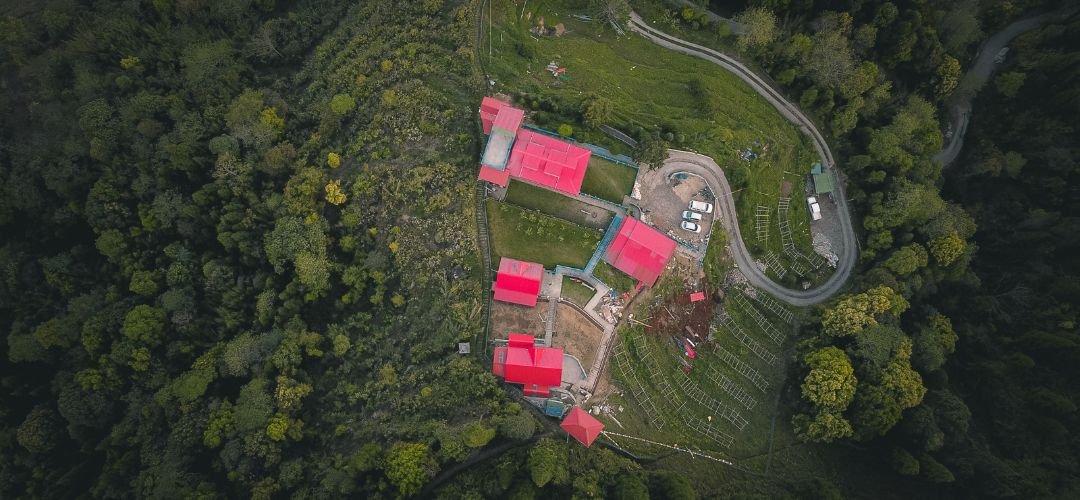


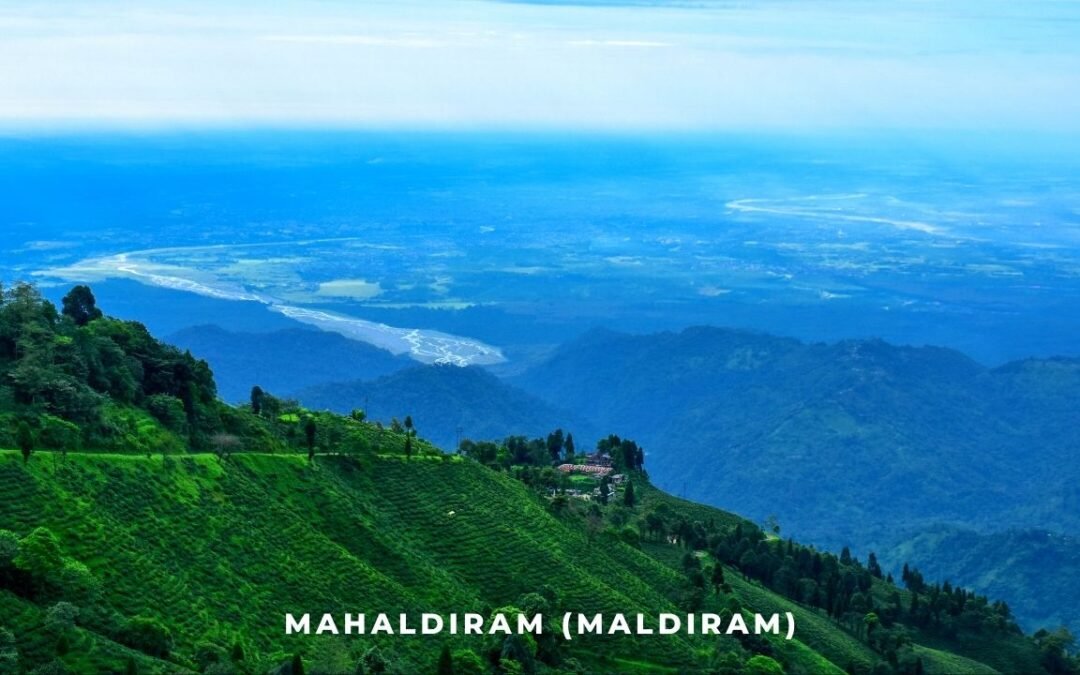
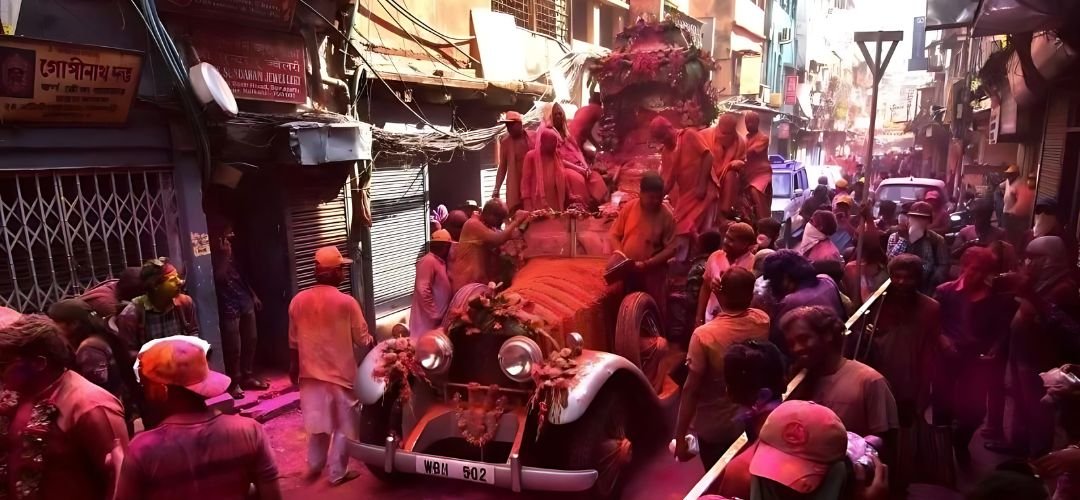
Interest grows automatically as I read one after another paragraph. History was interesting and curious in general but as I go through the article along with the grasping the pix of old mosque or other dilapidated remains of 500 bc to the dynasty is sha ,it keep me reading one page after another leaves other works undone.
Thank you so much. Glad that you liked it.
I have visited the place yesterday.. and Indo- Bangladesh border also.. very good place.. you have described here is helpful for the tourists lover.. very nice 👌
Thank you so much for your comment. We are so glad that you had a great trip in Malda.
Thanks for your beautiful description. Can we visit this place during monsoon? Can you please suggest some hotel where we can stay ?
Hello Sreeya! Yes, you can visit in the monsoons. Malda usually has a late monsoon compared to Kolkata and the southern part of Bengal. The best place to stay at Malda is the Malda Tourist Lodge. There are many other hotels in the area as well.